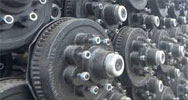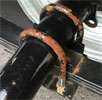 HOME | 1 | 2 | |
|||||||
Pontoon Trailer: Axles, Hubs & Bearings |
|||||||
| AXLES | |||||||
The axle itself is nothing
but a piece of steel with a
spindle and mounting plate
welded to each end. Some
trailer manufacturers make
their own axles while others
find it simpler to purchase
them. Axle manufacturers
have worked to build brand
name recognition: Al-Co,
Dexter, Reliable etc. There
may be some slight benefit
of one brand over another.
The quality story, if there
is one, lies in the bearings
and the hubs. Hubs are rated
by their carrying capacity
and have to meet certain
Department of Transportation
requirements for the rating.
Thus an axle with “cheap”
imported hubs and bearings
(and most of them used today
are imported) will do what
it’s supposed to do. You’ll
seldom hear a pontoon
trailer manufacturer touting
the quality of their axles.
There really just isn’t much
to claim, except the
carrying capacity.  |
|||||||
 Axles are vendor items for most trailer manufactures. Axle builders usually just spray paint the axles. They get scratched in transit and assembly. They seldom get touched up. Some companies claim they’re beneath the trailer, no one will notice. But many boats are off the trailer, often six months a year, when the axles rust, you will notice. Custom builders and higher quality companies use Aluminized axles. An aluminized coating helps prevent corrosion. It’s just cosmetic and isn’t much more expensive, but it’s a clue to the quality of the trailer your buying. |
|||||||
|
|||||||
 |
|||||||
  Spring axles are mounted with U bolt, these are called hanger brackets. There is no wrong or right way to mount them. I prefer when the bracket and nuts are on top. Many trailers are assembled on site, at a dealer or distributor, rather than at the manufacturer. It’s an extra safety precaution to be able to see that the nuts are on tight. The image to the left is Aluminized, nuts on top. The image to the right is painted with nuts on the bottom. |
|||||||
| Adjustable Axles | |||||||
 
Some large national
trailer manufacturers
use adjustable axles.
It’s a feature that is
usually not advertised
because adjustable axles
have gotten some bad
publicity. The benefit
is to the manufacturer.
They can stack more
trailers for shipping if
the distributor or
dealer puts the axles
on.
Bolting the axle is not generally a cost savings to the manufacturer. But it is a labor saving benefit in the manufacturing process. Attaching the axle to the frame is done by the distributor or dealer. This has given bolt on axles a bad reputation. |
|||||||
 People assembling trailers in distributors or dealerships are generally not master mechanics, more often they are low paid “yard boys”. The chances of getting an axle on crooked or misaligned can be great. Even just off an inch will make the trailer “dog track” and wear the tires. Another problem is if the bolts aren’t on absolutely tight, a extreme shock (such as a pot hole) can loosen the bolts. |
|||||||
| Spring Axle Assemblies | |||||||
| The majority of pontoon trailer manufacturers use spring axle assemblies. | |||||||
 |
|||||||
| Springs, like axles, are almost generic. When properly matched they carry your pontoon smoothly on good roads and help take the bounce out of rough ones. The axle assembly derives it’s capacity from the rating of the hub and the number of leaf springs. Fishing boat trailers may have only two springs. Most pontoon trailers will have four and heavy duty trailers may have five springs. Most trailer manufacturers simply state that the axle has a capacity of 2000, 2700, or 3500 lb. It’s usually stamped somewhere on the axle. The trailer owner should be aware of the carrying capacity. A axle with a 2700 lb. carrying capacity matched with a trailer that weighs about 600 lb. means the pontoon trailer can carry about 2100 lb. Most modern pontoon boats are over 2000 lbs. | |||||||
| The Weight Equalizer | |||||||
 I
generally prefer spring
axles to torsion axles.
Especially for larger
heavier pontoons for one
simple feature. Spring axles
tied together in a tandem
axle system have the weight
of the load (boat) equalized
by a “rocker” in the middle.
It helps distribute the
weight of the boat between
the front and back axles,
equalizing the load. It is a
big benefit on bad roads. If
the front wheel goes down in
a pot hole, the equalizer
raises the back wheel so as
to prevent it from falling
quite as deep in the hole.
Helping it to “walk” over
the hole. You’ll feel the
jarring effect of the front
wheel but the back wheel
won’t hit quite as hard. I
generally prefer spring
axles to torsion axles.
Especially for larger
heavier pontoons for one
simple feature. Spring axles
tied together in a tandem
axle system have the weight
of the load (boat) equalized
by a “rocker” in the middle.
It helps distribute the
weight of the boat between
the front and back axles,
equalizing the load. It is a
big benefit on bad roads. If
the front wheel goes down in
a pot hole, the equalizer
raises the back wheel so as
to prevent it from falling
quite as deep in the hole.
Helping it to “walk” over
the hole. You’ll feel the
jarring effect of the front
wheel but the back wheel
won’t hit quite as hard. |
|||||||
| Torsion Axles | |||||||
 |
|||||||
|
An alternative to spring
axles is the sealed rubber
torsion axle system. Springs
are replaced by rubber cords
inside the axle. The rubber
cords are compressed by the
“torsion” or twisting of the
axle inside. One of the
advantages of the torsion
axle system is that it is
very simple to mount. It’s a
benefit to the trailer
manufacturer and
distributor/dealer. They can
ship more trailers on a
stack. The
distributor/dealer can more
easily mount a torsion axle
than a spring axle. Usually
just four bolts. Generally
speaking torsion axles are
slightly more expensive, but
if you are shipping trailers
cross country, there is
freight savings with the
more trailers you can stack. I sold a line of trailers that used torsion axles for years. The claimed benefit was that they offered a smoother ride. When I was approached by another manufacturer I told them of my preference for torsion axles. Through actual towing demonstrations I was shocked to realize that I could not feel any difference. In fact, the spring axle handled a rough road better than the torsion axle. You can search the internet for the pros and cons and there may be some benefit towing with a smaller tow vehicle, but for modern pontoon boats I recommend and prefer the spring axle. |
|||||||
| HOME | 1 | 2 | | |||||||
| PONTOON TRAILERS 101 - FOR EVERYTHING YOU NEED TO KNOW ABOUT PONTOON BOAT TRAILERS | |||||||


